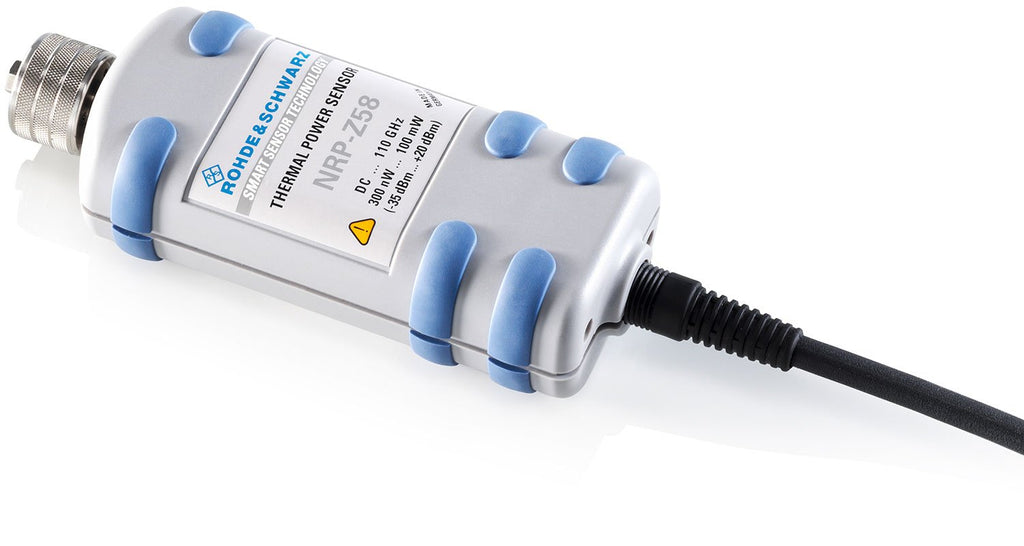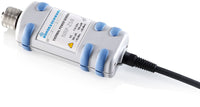- TestEquityHome
- Rohde & Schwarz Power Sensors
- Rohde & Schwarz Power Sensors
- Rohde & Schwarz NRP-Z92 Average Power Sensor, 6 GHz
- Rohde & Schwarz NRP-Z92 Average Power Sensor, 6 GHz
Rent our equipment. Own your results.
As the world’s largest test and measurement distributor, our engineers, technicians, and specialists support thousands of instruments from the industry’s top OEM brands in our fully accredited in-house calibration lab.
-
Fast Delivery -
Product Support -
Competitive prices
RELATED PRODUCTS
{"id":3546966196302,"title":"Rohde \u0026 Schwarz NRP-Z21 Three-Path Diode Power Sensors, 18 GHz","handle":"rohde-schwarz-nrp-z21-three-path-diode-power-sensors","description":"","published_at":"2019-05-07T11:39:53+01:00","created_at":"2019-05-07T11:55:56+01:00","vendor":"Rohde \u0026 Schwarz","type":"Power Sensors","tags":["Manufacturer_Rohde \u0026 Schwarz","Power Sensors","Product Type_Power Sensors","Rental","Rohde \u0026 Schwarz","UK Rental"],"price":0,"price_min":0,"price_max":0,"available":true,"price_varies":false,"compare_at_price":null,"compare_at_price_min":0,"compare_at_price_max":0,"compare_at_price_varies":false,"variants":[{"id":28142127153230,"title":"Default Title","option1":"Default Title","option2":null,"option3":null,"sku":"NRP-Z21","requires_shipping":false,"taxable":false,"featured_image":null,"available":true,"name":"Rohde \u0026 Schwarz NRP-Z21 Three-Path Diode Power Sensors, 18 GHz","public_title":null,"options":["Default Title"],"price":0,"weight":0,"compare_at_price":null,"inventory_management":null,"barcode":null,"requires_selling_plan":false,"selling_plan_allocations":[]}],"images":["\/\/vas.testequity.co.uk\/cdn\/shop\/products\/Rohde-Schwarz-NRP-Z23_e95554af-50ad-47b5-ba4e-7a1fbd171799.jpg?v=1689945518"],"featured_image":"\/\/vas.testequity.co.uk\/cdn\/shop\/products\/Rohde-Schwarz-NRP-Z23_e95554af-50ad-47b5-ba4e-7a1fbd171799.jpg?v=1689945518","options":["Title"],"media":[{"alt":"Rohde \u0026 Schwarz NRP-Z21 Three-Path Diode Power Sensors, 18 GHz | MCS Rentals","id":22688577093710,"position":1,"preview_image":{"aspect_ratio":1.537,"height":281,"width":432,"src":"\/\/vas.testequity.co.uk\/cdn\/shop\/products\/Rohde-Schwarz-NRP-Z23_e95554af-50ad-47b5-ba4e-7a1fbd171799.jpg?v=1689945518"},"aspect_ratio":1.537,"height":281,"media_type":"image","src":"\/\/vas.testequity.co.uk\/cdn\/shop\/products\/Rohde-Schwarz-NRP-Z23_e95554af-50ad-47b5-ba4e-7a1fbd171799.jpg?v=1689945518","width":432}],"requires_selling_plan":false,"selling_plan_groups":[],"content":""}
Rent our equipment. Own your results.
As the world’s largest test and measurement distributor, our engineers, technicians, and specialists support thousands of instruments from the industry’s top OEM brands in our fully accredited in-house calibration lab.
{"id":3547017314382,"title":"Rohde \u0026 Schwarz NRP-Z22 Three-Path Diode Power Sensors, 18 GHz","handle":"rohde-schwarz-nrp-z22-three-path-diode-power-sensors","description":"","published_at":"2019-05-07T12:14:59+01:00","created_at":"2019-05-07T12:14:59+01:00","vendor":"Rohde \u0026 Schwarz","type":"Power Sensors","tags":["Manufacturer_Rohde \u0026 Schwarz","Power Sensors","Product Type_Power Sensors","Rental","Rohde \u0026 Schwarz","UK Rental"],"price":0,"price_min":0,"price_max":0,"available":true,"price_varies":false,"compare_at_price":null,"compare_at_price_min":0,"compare_at_price_max":0,"compare_at_price_varies":false,"variants":[{"id":28142258290766,"title":"Default Title","option1":"Default Title","option2":null,"option3":null,"sku":"NRP-Z22","requires_shipping":false,"taxable":false,"featured_image":null,"available":true,"name":"Rohde \u0026 Schwarz NRP-Z22 Three-Path Diode Power Sensors, 18 GHz","public_title":null,"options":["Default Title"],"price":0,"weight":0,"compare_at_price":null,"inventory_management":null,"barcode":null,"requires_selling_plan":false,"selling_plan_allocations":[]}],"images":["\/\/vas.testequity.co.uk\/cdn\/shop\/products\/Rohde-Schwarz-NRP-Z23_2ad73988-23b4-491b-a114-d98bd69ae3af.jpg?v=1689945516"],"featured_image":"\/\/vas.testequity.co.uk\/cdn\/shop\/products\/Rohde-Schwarz-NRP-Z23_2ad73988-23b4-491b-a114-d98bd69ae3af.jpg?v=1689945516","options":["Title"],"media":[{"alt":"Rohde \u0026 Schwarz NRP-Z22 Three-Path Diode Power Sensors, 18 GHz | MCS Rentals","id":22688577060942,"position":1,"preview_image":{"aspect_ratio":1.537,"height":281,"width":432,"src":"\/\/vas.testequity.co.uk\/cdn\/shop\/products\/Rohde-Schwarz-NRP-Z23_2ad73988-23b4-491b-a114-d98bd69ae3af.jpg?v=1689945516"},"aspect_ratio":1.537,"height":281,"media_type":"image","src":"\/\/vas.testequity.co.uk\/cdn\/shop\/products\/Rohde-Schwarz-NRP-Z23_2ad73988-23b4-491b-a114-d98bd69ae3af.jpg?v=1689945516","width":432}],"requires_selling_plan":false,"selling_plan_groups":[],"content":""}
Rent our equipment. Own your results.
As the world’s largest test and measurement distributor, our engineers, technicians, and specialists support thousands of instruments from the industry’s top OEM brands in our fully accredited in-house calibration lab.
{"id":3547145404494,"title":"Rohde \u0026 Schwarz NRP-Z23 Three-Path Diode Power Sensors, 18 GHz","handle":"rohde-schwarz-nrp-z23-three-path-diode-power-sensors","description":"","published_at":"2019-05-07T14:17:05+01:00","created_at":"2019-05-07T14:17:05+01:00","vendor":"Rohde \u0026 Schwarz","type":"Power Sensors","tags":["Manufacturer_Rohde \u0026 Schwarz","Power Sensors","Product Type_Power Sensors","Rental","Rohde \u0026 Schwarz","UK Rental"],"price":0,"price_min":0,"price_max":0,"available":true,"price_varies":false,"compare_at_price":null,"compare_at_price_min":0,"compare_at_price_max":0,"compare_at_price_varies":false,"variants":[{"id":28142865875022,"title":"Default Title","option1":"Default Title","option2":null,"option3":null,"sku":"NRP-Z23","requires_shipping":false,"taxable":false,"featured_image":null,"available":true,"name":"Rohde \u0026 Schwarz NRP-Z23 Three-Path Diode Power Sensors, 18 GHz","public_title":null,"options":["Default Title"],"price":0,"weight":0,"compare_at_price":null,"inventory_management":null,"barcode":null,"requires_selling_plan":false,"selling_plan_allocations":[]}],"images":["\/\/vas.testequity.co.uk\/cdn\/shop\/products\/Rohde-Schwarz-NRP-Z23.jpg?v=1689945514"],"featured_image":"\/\/vas.testequity.co.uk\/cdn\/shop\/products\/Rohde-Schwarz-NRP-Z23.jpg?v=1689945514","options":["Title"],"media":[{"alt":"Rohde \u0026 Schwarz NRP-Z23 Three-Path Diode Power Sensors, 18 GHz | MCS Rentals","id":22688577028174,"position":1,"preview_image":{"aspect_ratio":1.537,"height":281,"width":432,"src":"\/\/vas.testequity.co.uk\/cdn\/shop\/products\/Rohde-Schwarz-NRP-Z23.jpg?v=1689945514"},"aspect_ratio":1.537,"height":281,"media_type":"image","src":"\/\/vas.testequity.co.uk\/cdn\/shop\/products\/Rohde-Schwarz-NRP-Z23.jpg?v=1689945514","width":432}],"requires_selling_plan":false,"selling_plan_groups":[],"content":""}
Rent our equipment. Own your results.
As the world’s largest test and measurement distributor, our engineers, technicians, and specialists support thousands of instruments from the industry’s top OEM brands in our fully accredited in-house calibration lab.
{"id":3547266515022,"title":"Rohde \u0026 Schwarz NRP-Z41 Three-Path Diode Power Sensors, 40 GHz","handle":"rohde-schwarz-nrp-z41-three-path-diode-power-sensors","description":"","published_at":"2019-05-07T15:23:13+01:00","created_at":"2019-05-07T15:44:43+01:00","vendor":"Rohde \u0026 Schwarz","type":"Power Sensors","tags":["Manufacturer_Rohde \u0026 Schwarz","Power Sensors","Product Type_Power Sensors","Rental","Rohde \u0026 Schwarz","UK Rental"],"price":0,"price_min":0,"price_max":0,"available":true,"price_varies":false,"compare_at_price":null,"compare_at_price_min":0,"compare_at_price_max":0,"compare_at_price_varies":false,"variants":[{"id":28143205646414,"title":"Default Title","option1":"Default Title","option2":null,"option3":null,"sku":"NRP-Z41","requires_shipping":false,"taxable":false,"featured_image":null,"available":true,"name":"Rohde \u0026 Schwarz NRP-Z41 Three-Path Diode Power Sensors, 40 GHz","public_title":null,"options":["Default Title"],"price":0,"weight":0,"compare_at_price":null,"inventory_management":null,"barcode":null,"requires_selling_plan":false,"selling_plan_allocations":[]}],"images":["\/\/vas.testequity.co.uk\/cdn\/shop\/products\/ROHNRP-Z41-1.jpg?v=1689945511"],"featured_image":"\/\/vas.testequity.co.uk\/cdn\/shop\/products\/ROHNRP-Z41-1.jpg?v=1689945511","options":["Title"],"media":[{"alt":"Rohde \u0026 Schwarz NRP-Z41 Three-Path Diode Power Sensors, 40 GHz | MCS Rentals","id":22688576995406,"position":1,"preview_image":{"aspect_ratio":1.875,"height":800,"width":1500,"src":"\/\/vas.testequity.co.uk\/cdn\/shop\/products\/ROHNRP-Z41-1.jpg?v=1689945511"},"aspect_ratio":1.875,"height":800,"media_type":"image","src":"\/\/vas.testequity.co.uk\/cdn\/shop\/products\/ROHNRP-Z41-1.jpg?v=1689945511","width":1500}],"requires_selling_plan":false,"selling_plan_groups":[],"content":""}
Rent our equipment. Own your results.
As the world’s largest test and measurement distributor, our engineers, technicians, and specialists support thousands of instruments from the industry’s top OEM brands in our fully accredited in-house calibration lab.
{"id":3547296628814,"title":"Rohde \u0026 Schwarz NRP-Z55 Thermal Power Sensor, 44 GHz","handle":"rohde-schwarz-nrp-z55-thermal-power-sensor","description":"","published_at":"2019-05-07T16:13:55+01:00","created_at":"2019-05-07T16:14:16+01:00","vendor":"Rohde \u0026 Schwarz","type":"Power Sensors","tags":["Manufacturer_Rohde \u0026 Schwarz","Power Sensors","Product Type_Power Sensors","Rental","Rohde \u0026 Schwarz","UK Rental"],"price":0,"price_min":0,"price_max":0,"available":true,"price_varies":false,"compare_at_price":null,"compare_at_price_min":0,"compare_at_price_max":0,"compare_at_price_varies":false,"variants":[{"id":28143388590158,"title":"Default Title","option1":"Default Title","option2":null,"option3":null,"sku":"NRP-Z55","requires_shipping":false,"taxable":false,"featured_image":null,"available":true,"name":"Rohde \u0026 Schwarz NRP-Z55 Thermal Power Sensor, 44 GHz","public_title":null,"options":["Default Title"],"price":0,"weight":0,"compare_at_price":null,"inventory_management":null,"barcode":null,"requires_selling_plan":false,"selling_plan_allocations":[]}],"images":["\/\/vas.testequity.co.uk\/cdn\/shop\/products\/RS-NRP-Z57_d37bac5e-1b8b-4194-87ca-d1c09c11213b.jpg?v=1689945510"],"featured_image":"\/\/vas.testequity.co.uk\/cdn\/shop\/products\/RS-NRP-Z57_d37bac5e-1b8b-4194-87ca-d1c09c11213b.jpg?v=1689945510","options":["Title"],"media":[{"alt":"Rohde \u0026 Schwarz NRP-Z55 Thermal Power Sensor, 44 GHz | MCS Rentals","id":22688576962638,"position":1,"preview_image":{"aspect_ratio":1.873,"height":330,"width":618,"src":"\/\/vas.testequity.co.uk\/cdn\/shop\/products\/RS-NRP-Z57_d37bac5e-1b8b-4194-87ca-d1c09c11213b.jpg?v=1689945510"},"aspect_ratio":1.873,"height":330,"media_type":"image","src":"\/\/vas.testequity.co.uk\/cdn\/shop\/products\/RS-NRP-Z57_d37bac5e-1b8b-4194-87ca-d1c09c11213b.jpg?v=1689945510","width":618}],"requires_selling_plan":false,"selling_plan_groups":[],"content":""}
Rent our equipment. Own your results.
As the world’s largest test and measurement distributor, our engineers, technicians, and specialists support thousands of instruments from the industry’s top OEM brands in our fully accredited in-house calibration lab.
{"id":3548323315790,"title":"Rohde \u0026 Schwarz NRP-Z57 Thermal Power Sensor, 67 GHz","handle":"rohde-schwarz-nrp-z57-thermal-power-sensor","description":"","published_at":"2019-05-08T10:58:12+01:00","created_at":"2019-05-08T11:06:41+01:00","vendor":"Rohde \u0026 Schwarz","type":"Power Sensors","tags":["Manufacturer_Rohde \u0026 Schwarz","Power Sensors","Product Type_Power Sensors","Rental","Rohde \u0026 Schwarz","UK Rental"],"price":0,"price_min":0,"price_max":0,"available":true,"price_varies":false,"compare_at_price":null,"compare_at_price_min":0,"compare_at_price_max":0,"compare_at_price_varies":false,"variants":[{"id":28149556576334,"title":"Default Title","option1":"Default Title","option2":null,"option3":null,"sku":"NRP-Z57","requires_shipping":false,"taxable":false,"featured_image":null,"available":true,"name":"Rohde \u0026 Schwarz NRP-Z57 Thermal Power Sensor, 67 GHz","public_title":null,"options":["Default Title"],"price":0,"weight":0,"compare_at_price":null,"inventory_management":null,"barcode":null,"requires_selling_plan":false,"selling_plan_allocations":[]}],"images":["\/\/vas.testequity.co.uk\/cdn\/shop\/products\/RS-NRP-Z57.jpg?v=1689945508"],"featured_image":"\/\/vas.testequity.co.uk\/cdn\/shop\/products\/RS-NRP-Z57.jpg?v=1689945508","options":["Title"],"media":[{"alt":"Rohde \u0026 Schwarz NRP-Z57 Thermal Power Sensor, 67 GHz | MCS Rentals","id":22688576929870,"position":1,"preview_image":{"aspect_ratio":1.873,"height":330,"width":618,"src":"\/\/vas.testequity.co.uk\/cdn\/shop\/products\/RS-NRP-Z57.jpg?v=1689945508"},"aspect_ratio":1.873,"height":330,"media_type":"image","src":"\/\/vas.testequity.co.uk\/cdn\/shop\/products\/RS-NRP-Z57.jpg?v=1689945508","width":618}],"requires_selling_plan":false,"selling_plan_groups":[],"content":""}
Rent our equipment. Own your results.
As the world’s largest test and measurement distributor, our engineers, technicians, and specialists support thousands of instruments from the industry’s top OEM brands in our fully accredited in-house calibration lab.
{"id":3548332163150,"title":"Rohde \u0026 Schwarz NRP-Z58 Thermal Power Sensor, 110 GHz","handle":"rohde-schwarz-nrp-z58-thermal-power-sensor","description":"","published_at":"2019-05-08T11:16:22+01:00","created_at":"2019-05-08T11:16:22+01:00","vendor":"Rohde \u0026 Schwarz","type":"Power Sensors","tags":["Manufacturer_Rohde \u0026 Schwarz","Power Sensors","Product Type_Power Sensors","Rental","Rohde \u0026 Schwarz","UK Rental"],"price":0,"price_min":0,"price_max":0,"available":true,"price_varies":false,"compare_at_price":null,"compare_at_price_min":0,"compare_at_price_max":0,"compare_at_price_varies":false,"variants":[{"id":28149686075470,"title":"Default Title","option1":"Default Title","option2":null,"option3":null,"sku":"NRP-Z58","requires_shipping":false,"taxable":false,"featured_image":null,"available":true,"name":"Rohde \u0026 Schwarz NRP-Z58 Thermal Power Sensor, 110 GHz","public_title":null,"options":["Default Title"],"price":0,"weight":0,"compare_at_price":null,"inventory_management":null,"barcode":null,"requires_selling_plan":false,"selling_plan_allocations":[]}],"images":["\/\/vas.testequity.co.uk\/cdn\/shop\/products\/ROHNRP-Z58-1_17a1bf12-ad93-4090-9f74-2580ddbff6de.jpg?v=1689945506"],"featured_image":"\/\/vas.testequity.co.uk\/cdn\/shop\/products\/ROHNRP-Z58-1_17a1bf12-ad93-4090-9f74-2580ddbff6de.jpg?v=1689945506","options":["Title"],"media":[{"alt":"Rohde \u0026 Schwarz NRP-Z58 Thermal Power Sensor, 110 GHz | MCS Rentals","id":22688576897102,"position":1,"preview_image":{"aspect_ratio":1.875,"height":800,"width":1500,"src":"\/\/vas.testequity.co.uk\/cdn\/shop\/products\/ROHNRP-Z58-1_17a1bf12-ad93-4090-9f74-2580ddbff6de.jpg?v=1689945506"},"aspect_ratio":1.875,"height":800,"media_type":"image","src":"\/\/vas.testequity.co.uk\/cdn\/shop\/products\/ROHNRP-Z58-1_17a1bf12-ad93-4090-9f74-2580ddbff6de.jpg?v=1689945506","width":1500}],"requires_selling_plan":false,"selling_plan_groups":[],"content":""}
Rent our equipment. Own your results.
As the world’s largest test and measurement distributor, our engineers, technicians, and specialists support thousands of instruments from the industry’s top OEM brands in our fully accredited in-house calibration lab.
{"id":3548493152334,"title":"Rohde \u0026 Schwarz NRP-Z81 Wideband Power Sensor, 18 GHz","handle":"rohde-schwarz-nrp-z81-wideband-power-sensor","description":"","published_at":"2019-05-08T13:48:55+01:00","created_at":"2019-05-08T13:59:49+01:00","vendor":"Rohde \u0026 Schwarz","type":"Power Sensors","tags":["Manufacturer_Rohde \u0026 Schwarz","Power Sensors","Product Type_Power Sensors","Rental","Rohde \u0026 Schwarz","UK Rental"],"price":0,"price_min":0,"price_max":0,"available":true,"price_varies":false,"compare_at_price":null,"compare_at_price_min":0,"compare_at_price_max":0,"compare_at_price_varies":false,"variants":[{"id":28150404612174,"title":"Default Title","option1":"Default Title","option2":null,"option3":null,"sku":"NRP-Z81","requires_shipping":false,"taxable":false,"featured_image":null,"available":true,"name":"Rohde \u0026 Schwarz NRP-Z81 Wideband Power Sensor, 18 GHz","public_title":null,"options":["Default Title"],"price":0,"weight":0,"compare_at_price":null,"inventory_management":null,"barcode":null,"requires_selling_plan":false,"selling_plan_allocations":[]}],"images":["\/\/vas.testequity.co.uk\/cdn\/shop\/products\/nrpxxs-sn-sn-v-three-path-diode-power-sensors-side-view-rohde-schwarz_200_4192_2880_1620_6_967e6c72-d239-47d5-ba84-dd9d31aa8b4f.jpg?v=1690287986"],"featured_image":"\/\/vas.testequity.co.uk\/cdn\/shop\/products\/nrpxxs-sn-sn-v-three-path-diode-power-sensors-side-view-rohde-schwarz_200_4192_2880_1620_6_967e6c72-d239-47d5-ba84-dd9d31aa8b4f.jpg?v=1690287986","options":["Title"],"media":[{"alt":null,"id":22691642441806,"position":1,"preview_image":{"aspect_ratio":1.778,"height":1620,"width":2880,"src":"\/\/vas.testequity.co.uk\/cdn\/shop\/products\/nrpxxs-sn-sn-v-three-path-diode-power-sensors-side-view-rohde-schwarz_200_4192_2880_1620_6_967e6c72-d239-47d5-ba84-dd9d31aa8b4f.jpg?v=1690287986"},"aspect_ratio":1.778,"height":1620,"media_type":"image","src":"\/\/vas.testequity.co.uk\/cdn\/shop\/products\/nrpxxs-sn-sn-v-three-path-diode-power-sensors-side-view-rohde-schwarz_200_4192_2880_1620_6_967e6c72-d239-47d5-ba84-dd9d31aa8b4f.jpg?v=1690287986","width":2880}],"requires_selling_plan":false,"selling_plan_groups":[],"content":""}
Rent our equipment. Own your results.
As the world’s largest test and measurement distributor, our engineers, technicians, and specialists support thousands of instruments from the industry’s top OEM brands in our fully accredited in-house calibration lab.
{"id":3548558983246,"title":"Rohde \u0026 Schwarz NRP-Z85 Wideband Power Sensor, 40 GHz","handle":"rohde-schwarz-nrp-z85-wideband-power-sensor","description":"","published_at":"2019-05-08T14:35:05+01:00","created_at":"2019-05-08T14:43:10+01:00","vendor":"Rohde \u0026 Schwarz","type":"Power Sensors","tags":["Manufacturer_Rohde \u0026 Schwarz","Power Sensors","Product Type_Power Sensors","Rental","Rohde \u0026 Schwarz","UK Rental"],"price":0,"price_min":0,"price_max":0,"available":true,"price_varies":false,"compare_at_price":null,"compare_at_price_min":0,"compare_at_price_max":0,"compare_at_price_varies":false,"variants":[{"id":28150583001166,"title":"Default Title","option1":"Default Title","option2":null,"option3":null,"sku":"NRP-Z85","requires_shipping":false,"taxable":false,"featured_image":null,"available":true,"name":"Rohde \u0026 Schwarz NRP-Z85 Wideband Power Sensor, 40 GHz","public_title":null,"options":["Default Title"],"price":0,"weight":0,"compare_at_price":null,"inventory_management":null,"barcode":null,"requires_selling_plan":false,"selling_plan_allocations":[]}],"images":["\/\/vas.testequity.co.uk\/cdn\/shop\/products\/nrpxxs-sn-sn-v-three-path-diode-power-sensors-side-view-rohde-schwarz_200_4192_2880_1620_6.jpg?v=1690287985"],"featured_image":"\/\/vas.testequity.co.uk\/cdn\/shop\/products\/nrpxxs-sn-sn-v-three-path-diode-power-sensors-side-view-rohde-schwarz_200_4192_2880_1620_6.jpg?v=1690287985","options":["Title"],"media":[{"alt":null,"id":22691642409038,"position":1,"preview_image":{"aspect_ratio":1.778,"height":1620,"width":2880,"src":"\/\/vas.testequity.co.uk\/cdn\/shop\/products\/nrpxxs-sn-sn-v-three-path-diode-power-sensors-side-view-rohde-schwarz_200_4192_2880_1620_6.jpg?v=1690287985"},"aspect_ratio":1.778,"height":1620,"media_type":"image","src":"\/\/vas.testequity.co.uk\/cdn\/shop\/products\/nrpxxs-sn-sn-v-three-path-diode-power-sensors-side-view-rohde-schwarz_200_4192_2880_1620_6.jpg?v=1690287985","width":2880}],"requires_selling_plan":false,"selling_plan_groups":[],"content":""}
Rent our equipment. Own your results.
As the world’s largest test and measurement distributor, our engineers, technicians, and specialists support thousands of instruments from the industry’s top OEM brands in our fully accredited in-house calibration lab.
{"id":4829722804302,"title":"Rohde \u0026 Schwarz NRP-Z11 Three-Path Diode Power Sensor, 10 MHz - 8 GHz","handle":"rohde-schwarz-nrp-z11-three-path-diode-power-sensor-10-mhz-8-ghz","description":"","published_at":"2020-09-11T10:20:55+01:00","created_at":"2020-09-11T09:59:59+01:00","vendor":"Rohde \u0026 Schwarz","type":"Power Sensors","tags":["Manufacturer_Rohde \u0026 Schwarz","Power Sensors","Product Type_Power Sensors","Rental","Rohde \u0026 Schwarz","UK Rental"],"price":0,"price_min":0,"price_max":0,"available":true,"price_varies":false,"compare_at_price":null,"compare_at_price_min":0,"compare_at_price_max":0,"compare_at_price_varies":false,"variants":[{"id":32607420153934,"title":"Default Title","option1":"Default Title","option2":null,"option3":null,"sku":"NRP-Z11","requires_shipping":false,"taxable":false,"featured_image":null,"available":true,"name":"Rohde \u0026 Schwarz NRP-Z11 Three-Path Diode Power Sensor, 10 MHz - 8 GHz","public_title":null,"options":["Default Title"],"price":0,"weight":0,"compare_at_price":null,"inventory_management":null,"barcode":null,"requires_selling_plan":false,"selling_plan_allocations":[]}],"images":["\/\/vas.testequity.co.uk\/cdn\/shop\/products\/NRP-Z11_01_0523.jpg?v=1689945494"],"featured_image":"\/\/vas.testequity.co.uk\/cdn\/shop\/products\/NRP-Z11_01_0523.jpg?v=1689945494","options":["Title"],"media":[{"alt":"Rohde \u0026 Schwarz NRP-Z11 Three-Path Diode Power Sensor, 10 MHz - 8 GHz","id":22688576831566,"position":1,"preview_image":{"aspect_ratio":1.0,"height":300,"width":300,"src":"\/\/vas.testequity.co.uk\/cdn\/shop\/products\/NRP-Z11_01_0523.jpg?v=1689945494"},"aspect_ratio":1.0,"height":300,"media_type":"image","src":"\/\/vas.testequity.co.uk\/cdn\/shop\/products\/NRP-Z11_01_0523.jpg?v=1689945494","width":300}],"requires_selling_plan":false,"selling_plan_groups":[],"content":""}
Rent our equipment. Own your results.
As the world’s largest test and measurement distributor, our engineers, technicians, and specialists support thousands of instruments from the industry’s top OEM brands in our fully accredited in-house calibration lab.












